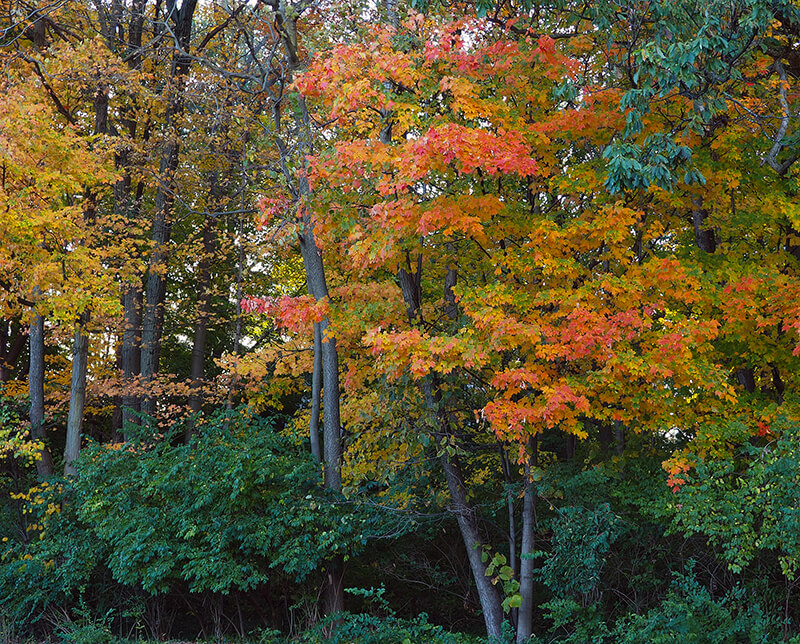December 4, 2017
Forest fungi boost invasive plants, choke out native species
 The underlying layer of vegetation in this maple-dominated central Indiana forest is filled with honeysuckle, an invasive plant species that crowds out economically important tree species such as oak.
Download image
The underlying layer of vegetation in this maple-dominated central Indiana forest is filled with honeysuckle, an invasive plant species that crowds out economically important tree species such as oak.
Download image
WEST LAFAYETTE, Ind. - Certain types of tree-associated fungi make a forest a welcoming environment for invasive plant species, crowding out natives, including high-value trees such as oaks.
The differences among mycorrhizal fungi, which have symbiotic associations with plant roots, is key to the type of impact they will have on non-native invasive species, according to a Purdue University study. Arbuscular mycorrhizal fungi grow inside the tissues of roots and are more common on maple or cherry trees. Ectomycorrhizal fungi live on the outside of a plant’s roots and are often found on oak, hickory and beech trees.
Songlin Fei, a forest ecologist in Purdue’s Department of Forestry & Natural Resources, said arbuscular mycorrhizal forests cycle through nutrients faster, breaking down more quickly the leaves and other plant litter that fall to a forest floor. Ectomycorrhizal forests, on the other hand, are slower to break down that plant material and leave a thick layer of litter on the ground.
“If invasive species arrive in a forest dominated by arbuscular mycorrhizal trees, they have easier access to soil and have higher nutrient concentrations needed to establish and grow,” said Fei, whose findings were published in the journal Ecology Letters. “In ectomycorrhizal forests, the litter layer is thicker and nutrient availability is poor, making it more difficult for these invasives to grow.”
As invasive species take hold, they take up space and nutrients needed by native plants.
“They can choke the regeneration and stop new seedlings from coming through,” Fei said. “Forests in the eastern United States are heavily invaded, with an average of 50 percent of forests invaded by at least one invasive plant species. In the central hardwood region like Indiana, sometimes 90 percent of the forests have been invaded. That is a huge economic and ecological issue.”
The state’s 2010 report “Indiana’s Hardwood Industry: Its Economic Impact” credits the hardwood industry with generating a $17 billion economic impact, including $1.2 billion in wages.
Understanding the factors influencing invasive species can help foresters and those in the hardwood industry determine the best approaches for addressing the problem. While managing invasive species in all forests is impossible, foresters and ecologists might use mycorrhizal information to focus on the most susceptible areas.
Fei’s findings come from surveys by the U.S. Forest Service that have identified more than 150 invasive species that are problematic for the health of native plants in forests. A national invasive plants distribution map can be found at Fei’s research website: http://web.ics.purdue.edu/~sfei/midas-data-products.php.
Fei’s research collaborators include: Insu Jo of Purdue’s Department of Forestry and Natural Resources, Kevin M. Potter of North Carolina State University’s Department of Forestry and Environmental Resources, and Grant Domke of the U.S. Forest Service Northern Research Station. The project is partially supported by the National Science Foundation’s Macrosystems Biology program.
Contact: Brian Wallheimer, 765-532-0233, bwallhei@purdue.edu
Source: Songlin Fei, 765-496-2199, sfei@purdue.edu
ABSTRACT
Dominant forest tree mycorrhizal type mediates understory plant invasions
Insu Jo1, Kevin M. Potter2, Grant M. Domke3, and Songlin Fei1
- Department of Forestry and Natural Resources, Purdue University, West Lafayette, IN
- Depatrment of Forestry and Environmental Resources, North Carolina State University, Research triangle Park, NC
- Northern Research Station, United States Department of Agriculture, Forest Service, St. Paul, MN
Forest mycorrhizal type mediates nutrient dynamics, which in turn can influence forest 34 community structure and processes. Using forest inventory data, we explored how dominant 35 forest tree mycorrhizal type affects understory plant invasions with consideration of forest 36 structure and soil properties. We found that arbuscular mycorrhizal (AM) dominant forests, 37 which are characterized by thin forest floors and low soil C:N ratio, were invaded to a greater 38 extent by nonnative invasive species than ectomycorrhizal (ECM) dominant forests. Understory 39 native species cover and richness had no strong associations with AM tree dominance. We also 40 found no difference in the mycorrhizal type composition of understory invaders between AM 41 and ECM dominant forests. Our results indicate that dominant forest tree mycorrhizal type is 42 closely linked with understory invasions. The increased invader abundance in AM dominant 43 forests can further facilitate nutrient cycling, leading to the alteration of ecosystem structure and 44 functions.
Agricultural Communications: (765) 494-8415;
Shari Finnell, Manager/Media Relations and Public Information, sfinnell@purdue.edu
Agriculture News Page

